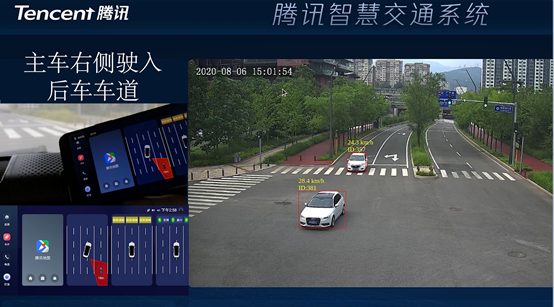Tencent cooperative vehicle infrastructure system relies on road-side unit (RSU) , road sensing equipment (such as camera) and 5G base station to realize the information closed-loop among the connected vehicles. In addition, the edge cloud computing of the system is connected to central csloud (traditional data center) through external network lines (such as 4G/5G, CPE or carriers’ special lines), which achieves large-scale network coverage with 5G base station, makes up the lack of network coverage in roadside infrastructure, and realize the integration of vehicle-road-cloud-network by using the powerful computing power of the central cloud (such as traffic brain).
Edge cloud computing infrastructure can improve data processing capacity of existing roadside infrastructure. With the deployment of AI processing workstation, the edge cloud infrastructure can analyze each target in road-side camera (include vehicles, pedestrians, scatters, traffic accidents, etc.). The main functions are as follows:
1)Target recognition and detection: recognize and detect road targets (including vehicles, pedestrians, scatters, traffic accidents, etc.).
2)Target tracking: track the road targets accurately. Unique recognize and exclude repetitive tracking when multiple cameras capture the same target.
3)Location & velocity & direction: locate the target in real time and compute the speed and direction of it.
4)GNSS high precision positioning: based on the original GNSS position measured by the vehicle, the edge cloud can realize high precision positioning without special RTK terminal. Besides, the information can be delivered to connected vehicles and other modules of the edge cloud to judge the main car and abnormal scene. Compared with the method of using GPS as positioning reference, the accuracy is greatly improved without increasing the cost.
5)Abnormal scene recognition: the recognition scenes include emergency braking, parking, abnormal lane change, left turn, reverse driving, large trucks, vulnerable traffic participants, scatters, Lane level congestion, etc.
Visual recognition of emergency braking scene
Visual recognition of vehicle left turn scene
Visual recognition of Vulnerable traffic participants scene
In Tencent cooperative vehicle infrastructure system open platform, for edge cloud and central cloud system, we built a vehicle-road cooperative edge computing platform with good ecological openness based on Tencent cloud-edge collaborative system TMEC:
Flexible aggregation of third party system: the platform is completely decoupled from the third-party system, and the original road data collected by roadside infrastructure is directly provided to the third party system by means of senseless forwarding through the programmable data retransmission system. In addition, edge cloud and center cloud connect with third-party systems (such as traffic monitoring center) through specific open data interfaces. Edge cloud can share structured v2x information with third-party systems, while center cloud can provide big data interface to third-party systems, providing big data processing and analysis functions for third-party applications.
Seamless connection to 5G / V2X network: the platform supports the connected vehicles service deployed by edge cloud to seamlessly connect to 5G / V2x network, and can simultaneously adapt v2x messages to 5G base station (Uu Interface) and C-V2X RSU (PC5 interface) transmission, and support for 5G Internet of vehicles and cloud game business under high-speed vehicle scene, using innovative 5G end-to-end slice activation for application and location, AI weak network detection, MEC resource scheduling for Internet business and other technologies, to achieve seamless docking for 5G/V2X. The platform adopts Tencent self-developed micro service framework to realize service-oriented governance of edge cloud business including third-party business. The framework has been adopted by 3GPP SA2 R16 as one of the four main solutions of 5G core network service architecture evolution (eSBA) (the other three are traditional telecom equipment provider solutions), and has been partially adopted by 3GPP standards TS23.501 and TS23.502.
Low-cost platform: due to the openness of the platform, it can make full use of the existing infrastructure and flexibly aggregate the third-party system, so it can greatly reduce the cost for the users. The current system integrates Intel low-cost computing hardware in the edge cloud, which greatly reduces the computing power cost by 50% and reduces the energy consumption of the edge cloud by 60%. In addition, by using cloud GNSS high-precision positioning method, compared with the traditional RTK solution, the cost of connected vehicle terminal can be reduced by about 90% under the condition of slightly reducing the positioning accuracy (but meeting the requirements of lane level positioning).


